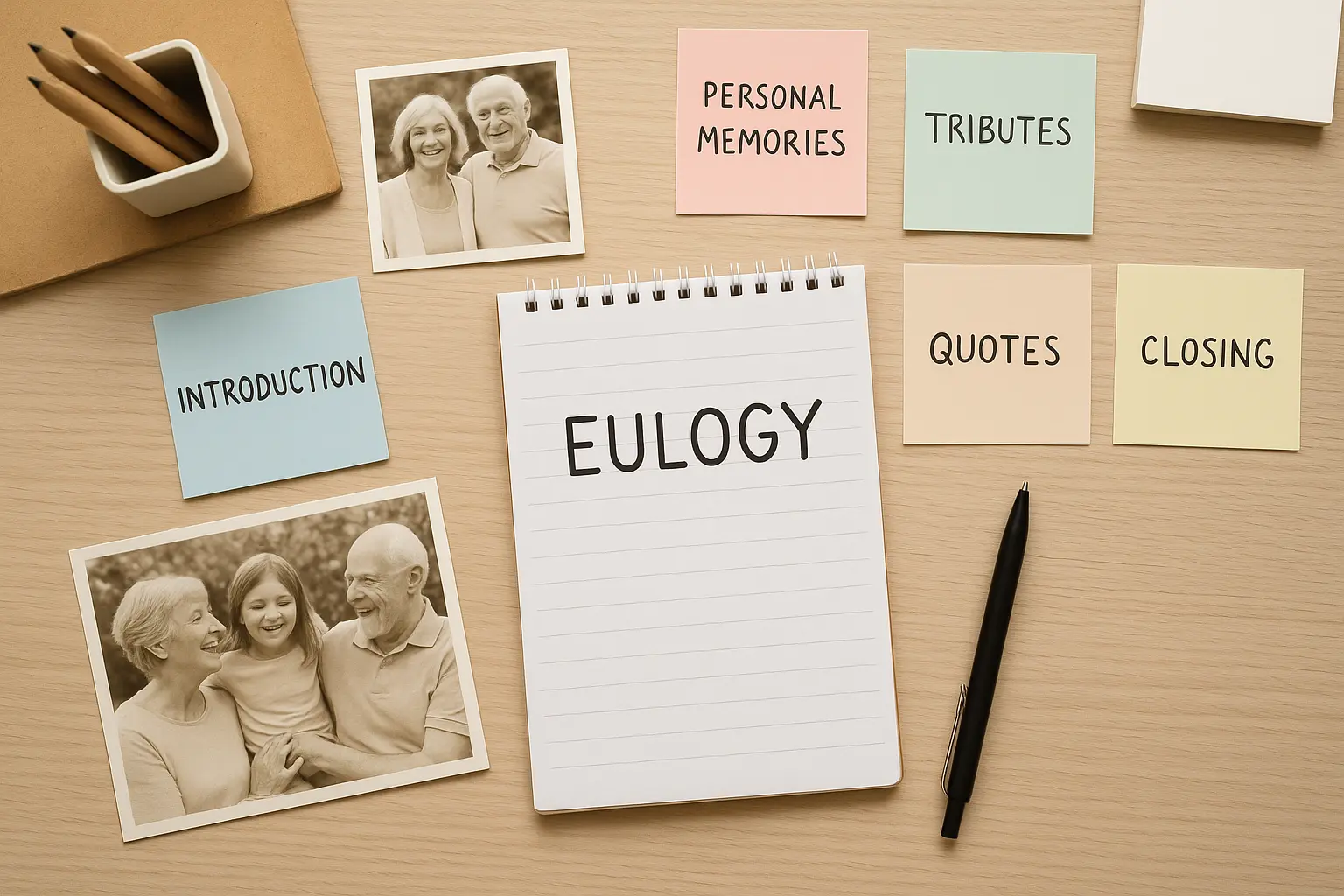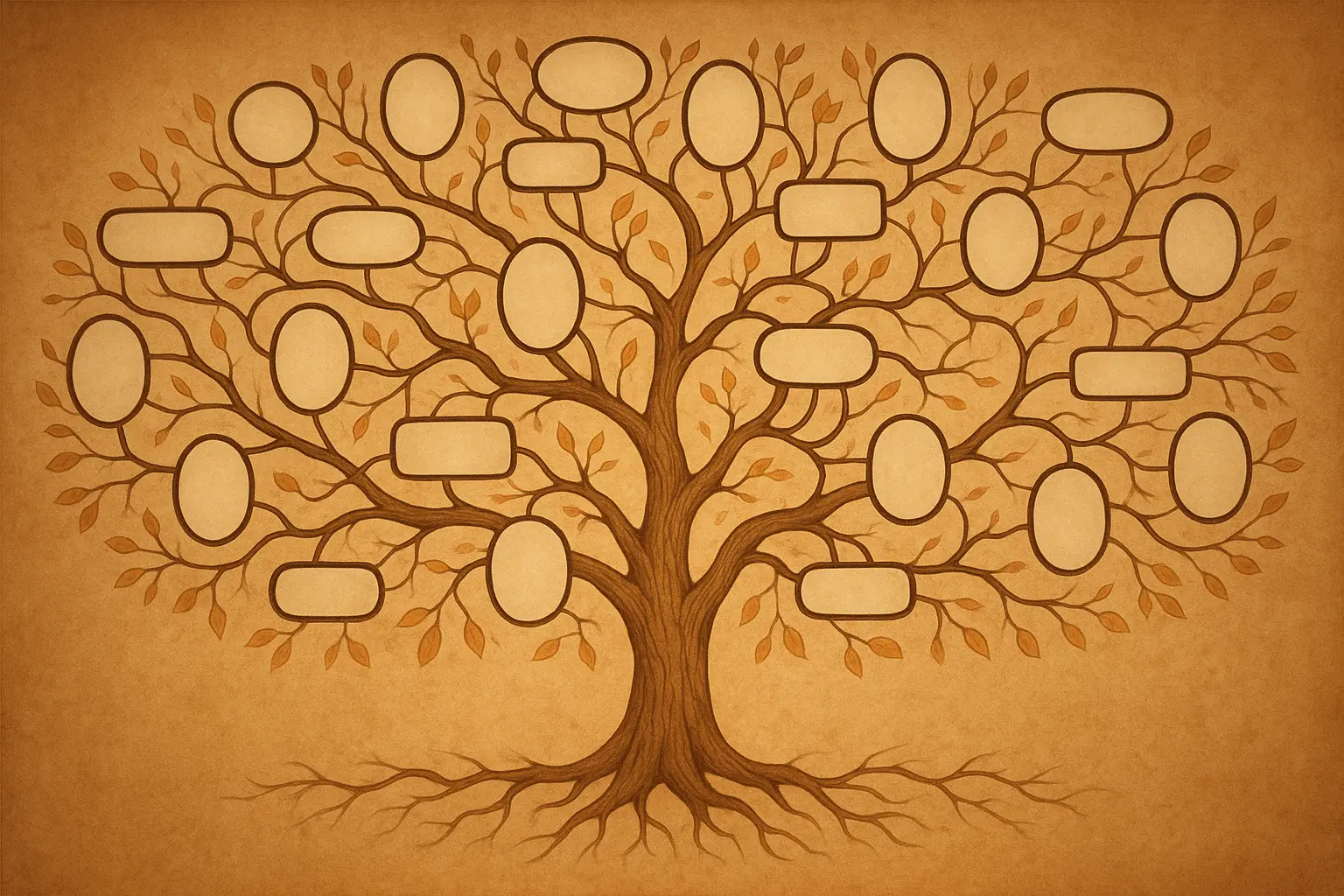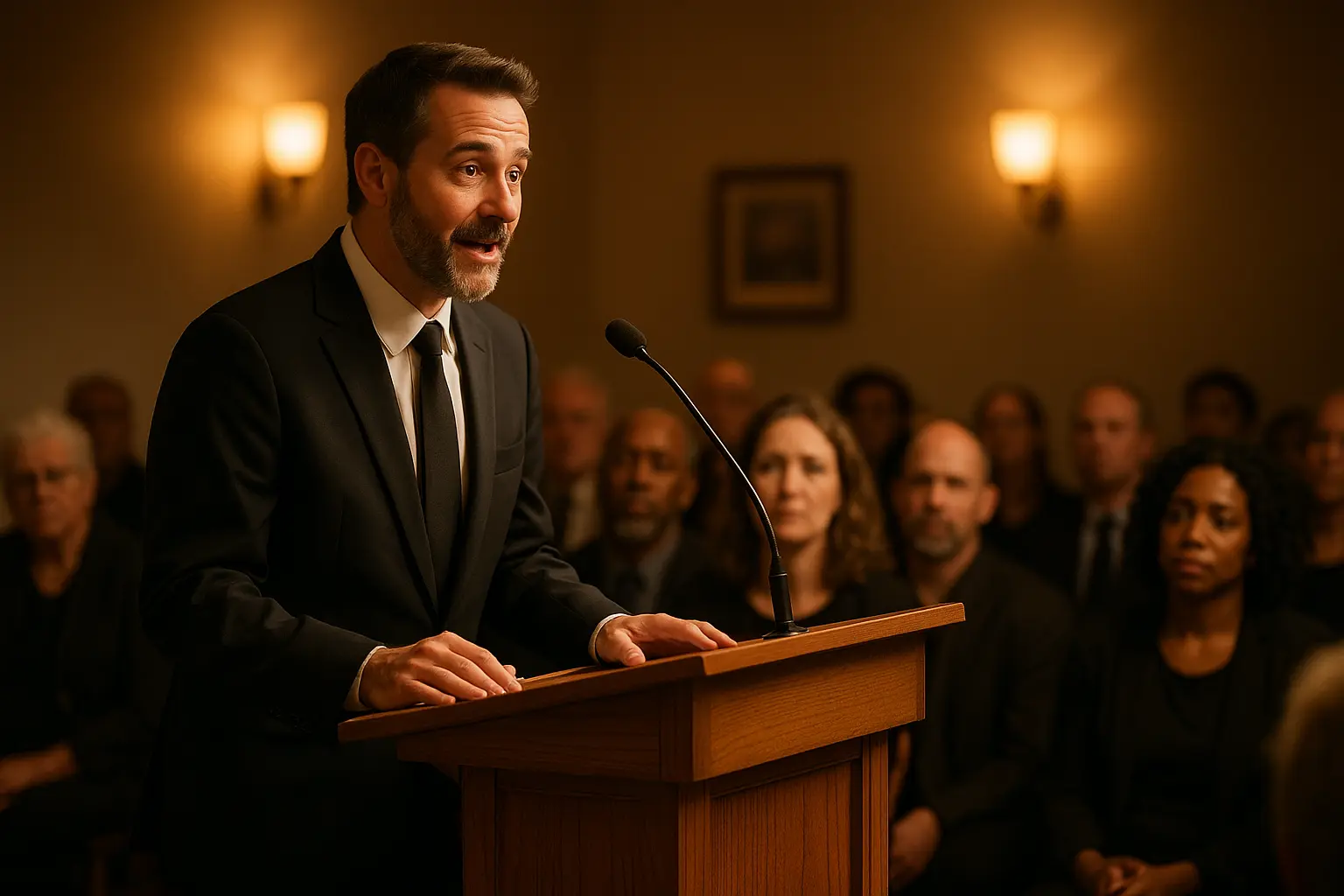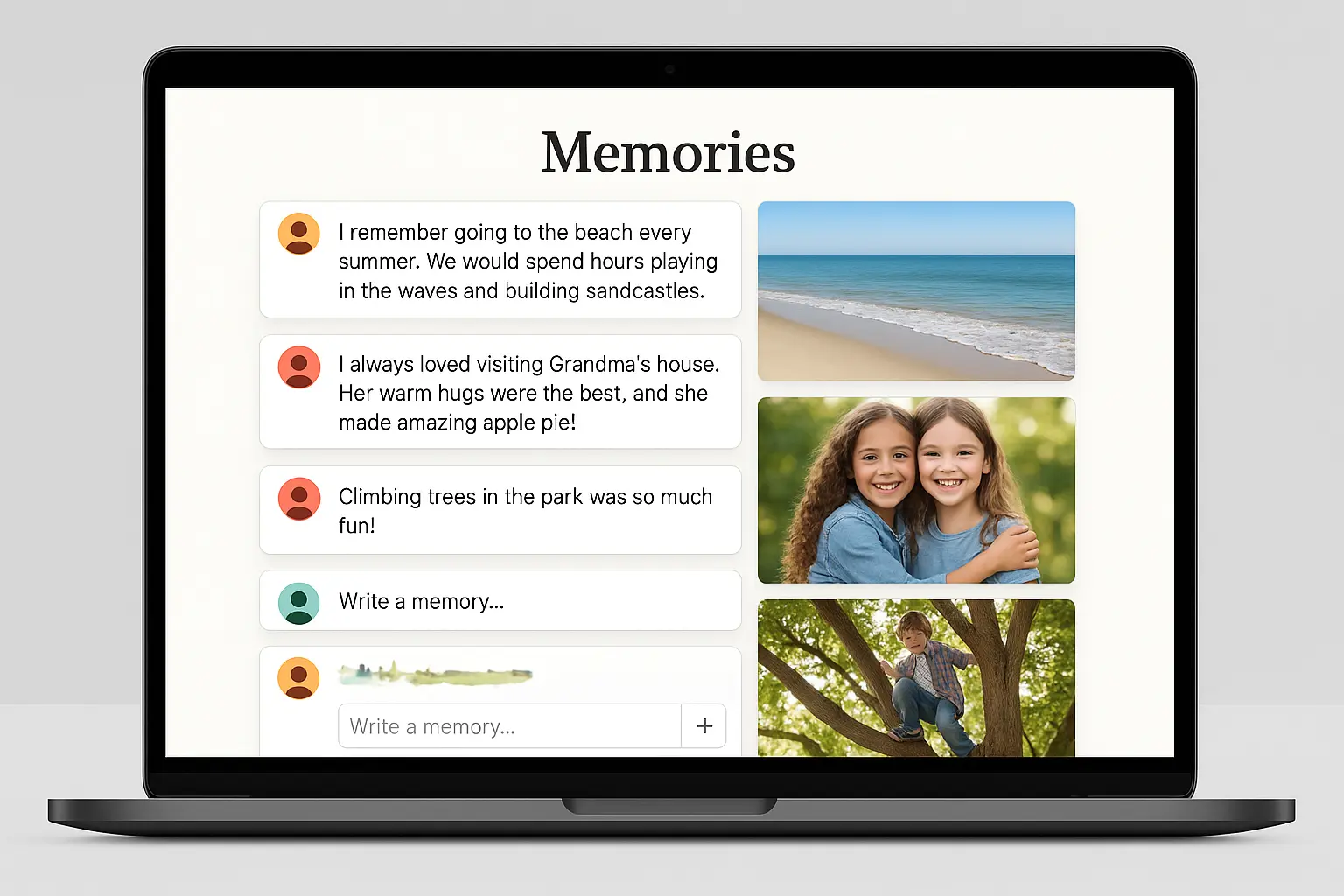The blank page stares back at you. Your loved one deserves beautiful words, but right now, you can barely think straight through the grief. I get it – and you’re not alone in feeling lost about where to start.
Quick Resource:
If you’re struggling to write a meaningful tribute, the Eulogy Generator can guide you step-by-step through the process of creating a heartfelt, personal speech that honors your loved one’s life with authenticity and grace.
Writing a eulogy when you’re drowning in sorrow feels impossible, but it doesn’t have to break you. This guide will walk you through turning scattered memories into something that captures who they really were. From understanding what makes some eulogies unforgettable while others fall flat, to managing your emotions during delivery, you’ll discover how to create a tribute that brings comfort to everyone listening – including yourself.
According to Cabot and Sons Funeral Home, most eulogies run about 4-7 minutes – just enough time to share the stories that matter most. This timeframe gives you boundaries when everything feels overwhelming, helping you focus on what truly captures their essence rather than trying to summarize an entire life.

TL;DR
- Good eulogies help people heal by balancing honest memories with sensitivity
- Start by collecting stories, then organize them into a simple structure you can follow
- Different relationships need different approaches – what works for a parent won’t work for a friend
- Consider cultural and religious traditions, but don’t let them overshadow who the person really was
- Practice helps, but perfection isn’t the goal – authenticity is what people need to hear
- Modern tools and professional services exist when grief makes writing too overwhelming
- Remember: an imperfect eulogy delivered with love beats a perfect speech delivered without heart
What Makes Some Eulogies Unforgettable (While Others Fall Flat)
The best eulogies don’t just tell us what happened – they help us feel who this person was. When someone nails it, you walk away thinking “Yes, that was exactly them.” When they don’t, you feel like you attended a stranger’s funeral.
Why This Matters More Than You Think
Writing a eulogy forces you to do something grief doesn’t usually allow – it makes you focus on celebration instead of just loss. I’ve watched people discover things about their loved ones they never knew, just through the process of gathering stories from others.
The real power happens when you realize you’re not just telling stories – you’re helping everyone in that room process their grief together. That shared experience of remembering creates connection when people feel most alone.
As “Write Your Eulogy Today” John Pavlovitz observes, “I think most of us would probably like to write the story that people tell about us after we’re gone.” This insight highlights how eulogies serve not just the deceased, but also help the living understand what truly matters in life and legacy.
When you’re learning how to write a eulogy, understanding its healing purpose becomes as important as the tribute itself, which is why our comprehensive eulogy writing guide emphasizes both emotional healing and meaningful remembrance.
Feeling overwhelmed? The Eulogy Generator helps you organize your thoughts and create a speech that feels true to your heart.
Who Should Give the Speech
Don’t assume you have to speak just because you’re family. Sometimes the best eulogies come from unexpected people – the neighbor who saw them every morning, the coworker who knew their sense of humor, or the friend who shared a completely different side of their life.
There’s no shame in recognizing your limits during grief. Professional eulogists exist for exactly these situations, and asking for help doesn’t mean you loved them any less.

The Pieces That Make It Work
Every memorable eulogy has certain elements that work together. You need an opening that immediately connects people to who this person was – not some generic “we’re gathered here today” line, but something that makes everyone think “oh yes, that’s so them.”
Then you need stories that show rather than tell. Instead of saying “she was generous,” paint the picture: “Every winter, Mom would knit scarves for the entire bus stop, including the grumpy man who never said thank you. She’d leave them hanging on the fence with little notes that said ‘stay warm.'”
Finally, you need to acknowledge what they accomplished – but focus on impact, not just credentials. How did their work change people? What did they build that outlasted them? Sometimes the biggest achievements aren’t professional at all.
Research from Ministry Matters shows that “We remember stories more than facts” and that “Human beings are wired for story.” This explains why personal anecdotes resonate more deeply than biographical lists, making your memories the most powerful tool for honoring your loved one.
Looking at real eulogy examples can help you understand how powerful stories work in practice, which is why reviewing comprehensive eulogy examples from different relationships provides valuable inspiration for your own approach.
Not sure where to begin? Use the Eulogy Generator to turn your memories into a beautiful, structured tribute.

Where to Start When You’re Stuck
When grief makes your brain feel like static, you need a simple process to follow. This isn’t about creating perfect prose – it’s about organizing your love into words that make sense.
Collecting the Raw Material
Start by writing down everything you remember, in whatever order it comes. Don’t worry about making it pretty or organized yet. Just get it all out of your head and onto paper.
Then reach out to other people who knew them. Ask specific questions: “What’s your favorite memory with them?” “What did they teach you without realizing it?” “What would make them laugh if they could hear this eulogy?” These targeted questions unlock better stories than just asking people to “share memories.”
Create a simple way to collect these stories. You might set up a shared document where family members can add memories, or just make phone calls and take notes. Someone always remembers the story you forgot, or has photos that spark new memories you thought you’d lost.
Making Sense of the Chaos
Once you have all these scattered memories, group them by themes. Maybe it’s “family stories,” “work life,” and “community impact.” Or perhaps “early years,” “middle years,” and “recent memories.” Find the pattern that makes sense for how they lived.
The Eulogy Generator makes it simple to organize your memories and create a eulogy that flows naturally.
Don’t try to include everything. Choose the stories that best show who they were – the ones that make people nod and smile because they capture something essential about this person.

Making It Sound Right
Read your first draft out loud. You’ll immediately hear what doesn’t work. Sentences that seemed fine on paper might feel clunky when spoken, or you might discover you’re trying to cram too much into one breath.
Get feedback from someone who knew them well. They can tell you if you’ve captured their essence accurately and suggest stories you might have missed. Sometimes an outside perspective helps you see what’s most important.
According to Funeral Partners UK, a good eulogy is usually between 3-5 minutes long, but can be as long as 10 minutes. Use this as a guide during revision – if your draft runs longer, focus on the most impactful stories rather than trying to include everything.
Getting Ready for the Moment
Practice doesn’t mean memorizing every word. It means becoming comfortable enough with your content that you can keep going even if emotions take over. Know your key points well enough that you can find your way back if you lose your place.
Have backup plans. Print multiple copies, ask someone to be ready to step in if needed, and don’t be afraid to pause if you need a moment. The audience understands – they’re feeling it too.

Writing for Different People in Your Life
The eulogy for your mom needs a different approach than one for your best friend or colleague. Each relationship has its own emotional landscape and shared experiences that shape how you should tell their story.
When It’s Family
Writing eulogies for family members means navigating complex emotions and decades of shared history. These are the people who shaped who you are, which can make it both easier and harder to find the right words.
Parents and Grandparents
Writing about a parent feels overwhelming because where do you even start? They influenced everything about who you became. Focus on specific lessons they taught – not through lectures, but through how they lived their daily lives.
For grandparents, talk about their role as family storytellers and tradition keepers. The recipes they passed down, the stories they told about “the old days,” the way they made holidays special. These details matter more than you might think.
Whether you’re crafting a tribute for your mother or father, specialized guidance can help you navigate the unique emotional challenges of honoring those who shaped your entire world, which is why our parent eulogy guide addresses these complex feelings.
Get compassionate guidance with the Eulogy Generator — designed to help you write a eulogy that feels deeply personal and sincere.
Siblings and Extended Family
Sibling eulogies can include inside jokes and shared memories that others might not understand – and that’s okay. Give enough context so everyone gets it, but don’t lose the intimacy that made your relationship special.
Extended family members often played specific roles – the fun aunt who always had candy in her purse, the uncle who told terrible puns, the cousin who felt more like a sibling. Honor those unique positions and how they enriched family gatherings.

Friends and Chosen Family
Friendship eulogies have a different energy because you chose each other. These relationships often center on shared adventures, mutual support during tough times, or bonds that formed around common interests or life stages.
The Friends Who Became Family
Talk about how you met and what drew you together. Childhood friends deserve recognition for growing up alongside you despite all of life’s changes. Adult friendships often have different stories – maybe you bonded over shared struggles, celebrated each other’s successes, or simply enjoyed each other’s company through ordinary moments.
Friend eulogies require a different emotional approach than family tributes, focusing on chosen bonds and shared adventures, which is why our detailed friend eulogy guide helps you navigate the unique dynamics of honoring someone who chose to be part of your life story.
Work and Community Connections
Professional eulogies should focus on impact rather than job titles. How did they make the workplace better? Who did they mentor? What changes did they champion that outlasted their time there?
Community eulogies celebrate civic engagement and volunteer work. These are people who made their corner of the world better, and that deserves recognition alongside their personal relationships.
The recent eulogy for Jimmy Carter by Walter Mondale demonstrates how professional relationships can evolve into deep personal bonds. As Mondale shared in “Walter Mondale’s Jimmy Carter Eulogy” Town & Country, “We became very close friends. We often spent hours together throughout the day. We were working on real problems, not wasting time.” This shows how professional eulogies can celebrate both achievements and the personal connections that made work meaningful.
Workplace relationships often blend professional respect with personal affection, requiring specialized approaches that our colleague eulogy guide addresses through examples that honor both career achievements and personal connections formed in professional settings.
Handling Cultural Expectations and Raw Emotions
Every family and community has expectations about what should and shouldn’t be said at funerals. Navigating these while staying true to who your loved one really was requires sensitivity and sometimes difficult choices.
Honoring Their Faith and Heritage
If faith was important to them, don’t ignore it just because it makes you uncomfortable. Include the prayers they loved, the hymns they hummed, or the spiritual concepts that guided their decisions. You’re not trying to convert anyone – you’re honoring who they were.
When you’re speaking to people from different faith backgrounds, focus on universal themes while still acknowledging their specific beliefs. Most people appreciate learning about traditions that were meaningful to someone they cared about.
Cultural traditions often shaped how they approached life, family, and community. Include the customs that mattered to them, the foods they made for special occasions, or the stories they told about their heritage. Don’t assume everyone knows about their background – brief explanations help people understand why certain traditions were meaningful.

Being Honest Without Hurting People
Nobody was perfect, and pretending they were doesn’t honor their memory. The question is how to acknowledge their full humanity without causing pain to people who are already grieving.
Consider your audience carefully. What might feel healing to share with close family could be inappropriate for a larger gathering. Sometimes you can acknowledge struggles in ways that show growth or learning: “Dad’s determination could drive us crazy – like when he insisted on fixing that leaky faucet for three weekends straight instead of calling a plumber. But that same stubborn streak is what got him through chemotherapy with his sense of humor intact.”
When Writing Becomes Healing
Writing a eulogy forces you to process memories in a structured way. You’ll find yourself working through emotions as you decide which stories to include and how to tell them. This is normal and can be surprisingly therapeutic.
Don’t try to do this alone if you don’t want to. Reach out to friends, family, counselors, or support groups during the writing process. Shared grief often leads to deeper, more meaningful tributes than struggling in isolation.
You don’t have to do this alone. The Eulogy Generator walks beside you through each step of writing with empathy and clarity.
Making Your Words Really Land
The difference between a eulogy that moves people and one that falls flat often comes down to storytelling techniques and delivery. You don’t need to be a professional speaker, but a few key approaches can make your words much more powerful.
Stories That Bring Them Back to Life
Instead of telling people your loved one was generous, show them: “Every Christmas morning, Dad would sneak out before dawn to shovel the elderly neighbor’s driveway, then act surprised when she thanked him later.”
Use specific details that help people see, hear, and feel the moment. The sound of their laugh, the way they moved their hands when they talked, the smell of their cooking – these details bring them back to life for a few precious minutes.
Choose stories that take people on a small emotional journey. Start with something that makes them smile, move through deeper reflections, and end with hope or celebration.

Finding the Right Words
Skip generic descriptions that could apply to anyone. Instead of “wonderful person,” show us what made them wonderful. Instead of “loving father,” tell us about the bedtime stories, the terrible dad jokes, or the way he never missed a game.
Your word choices should match both the seriousness of the occasion and the intimacy of your relationship. You can be respectful without being stiff, personal without being inappropriate.
Delivering With Heart
Slow down. Grief makes us want to rush through difficult parts, but your audience needs time to process emotional moments. Pause after important points. Let meaningful statements settle.
When your voice starts to break, don’t fight it. Pause, take a breath, and continue. People understand – they’re feeling it too. Having water nearby isn’t just practical, it’s essential.
Make eye contact with different sections of the room. You’re not just reading to them – you’re sharing with them. Include the audience by acknowledging shared memories: “I know many of you have your own stories about her terrible sense of direction” (pause for gentle laughter).
Watch the room’s energy. If people seem overwhelmed, slow down or lighten the tone slightly. If they’re engaged and connecting, lean into that. Flexibility matters more than perfect execution.

When You Need Extra Help
Sometimes grief makes writing impossible, or you’re too close to the situation to find the right words. That’s completely normal, and there are resources designed specifically for these moments.
Digital Tools That Actually Help
Writer’s block hits differently when you’re grieving. AI-powered tools can ask the right questions to unlock memories you forgot you had. They’re not writing for you – they’re helping you organize your thoughts when your brain feels scattered by loss.
The best platforms adapt to your specific relationship and circumstances. They ask different questions for a spouse versus a friend, for someone who died suddenly versus after a long illness. This personalization makes all the difference when you’re struggling to know where to start.
Family members scattered across the country can all contribute memories through shared platforms. Someone always remembers the story you forgot, or has photos that spark new memories you thought you’d lost. Real-time collaboration means you can get feedback and suggestions as you write, rather than trying to coordinate through endless email chains during an already stressful time.

Professional Writers Who Get It
Sometimes you’re too overwhelmed by grief to write effectively, or you’re too close to the situation to see it clearly. Professional eulogy writers specialize in interviewing families and translating those conversations into meaningful tributes.
They’re not just writers – they understand grief and know how to ask the right questions to uncover the stories that matter most. The best ones make it feel like a conversation with a compassionate friend who happens to be really good with words.
The Eulogy Generator bridges the gap between struggling alone and expensive professional services. Created by professional eulogy writer Jen Glantz, it combines AI efficiency with deep understanding of grief and remembrance. The platform asks thoughtful questions based on your specific relationship and circumstances, helping you organize memories when your mind feels scattered. With unlimited revisions and 24-hour support, you get professional-quality guidance without the professional price tag or timeline pressure.
Take the first step toward writing a beautiful tribute — try the Eulogy Generator today.
For those seeking inspiration before writing, reviewing an example eulogy can provide valuable insights into structure, tone, and emotional flow that make tributes truly memorable and healing for everyone involved.
You’ve Got This
Writing a eulogy when you’re drowning in grief feels impossible, but it’s also one of the most healing things you can do. You’re not just honoring them – you’re helping everyone who loved them process their loss together.
Your relationship with them was unique, which means your perspective matters in ways you might not realize. The stories only you know, the side of them only you saw, the impact they had on your specific life – that’s irreplaceable content that no one else can provide.
Don’t aim for perfection. Aim for truth. People don’t need a flawless speech – they need to feel connected to the person you’re all missing. Sometimes the most powerful eulogies include voice breaks, long pauses, and moments where emotion takes over. That’s human, and that’s exactly what everyone needs to see.
Whether you write every word yourself, use modern tools for guidance, or work with professionals, the goal remains the same: creating a tribute that captures who they really were and what they meant to all of you. Trust yourself to know what matters most, and don’t be afraid to show your love for them through every word you speak.
The blank page doesn’t have to stay blank forever. Start with one memory, one story, one thing that made them uniquely themselves. From there, the rest will come. And when you stand up to speak their name and share their story, you’ll be giving everyone in that room exactly what they need – a few minutes to remember not just that this person died, but how beautifully they lived.

